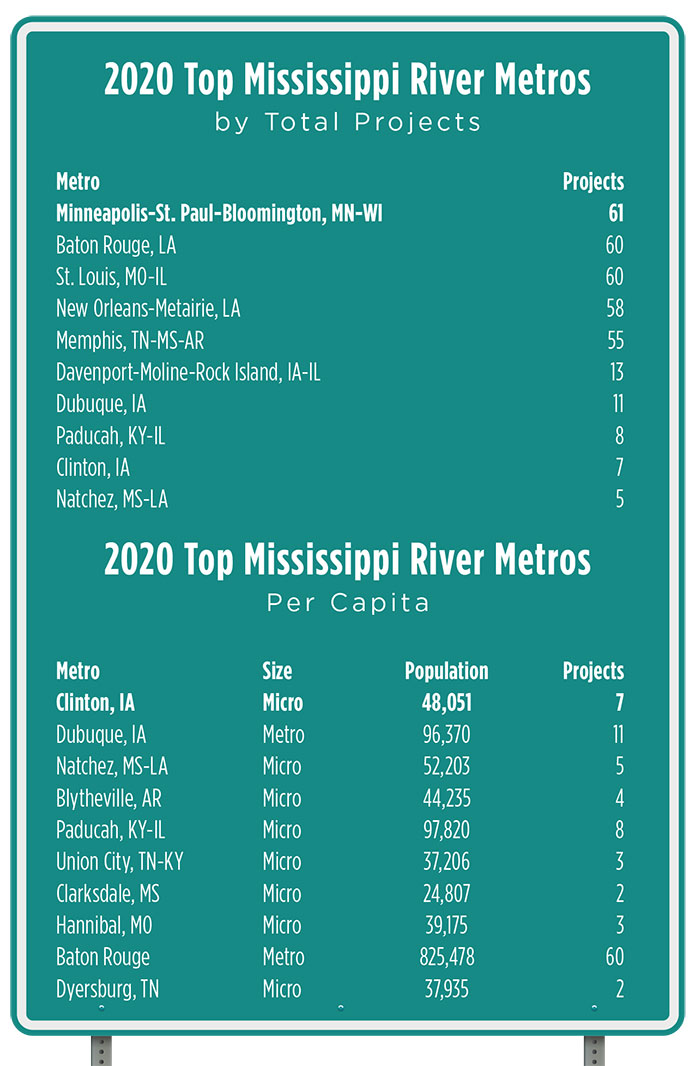As the cold winds of winter approached Iowa in late 2020, specialty fibers made residents of Clinton, Iowa, glow with warmth.
It wasn’t just parkas and wool. Japan’s Spiber Inc., a biotech startup that produces “brewed proteins” such as spider silk for use in clothing and other consumer products, announced in December it would invest $101.4 million to expand production of its plant-based polymers to Clinton, its first U.S. facility, through a partnership with ADM, which employs nearly 900 in the area.

Erin M. Cole, president and CEO of Clinton Regional Development Corporation (CRDC), says “Project Charlotte,” the code name for the Spiber project, moved forward quickly despite pandemic conditions. The city played a major role, working for over a year to arrange a land deal that made city-owned land near the chosen location available to Spiber for the expansion. An incentive package includes $1 million through Iowa’s High Quality Jobs (HQJ) Program, with the City of Clinton providing a 20% match.
Other major projects have come from Timken, which has moved some operations from a site across the river in Fulton, Illinois; Nestle Purina Petcare, with a $140 million, 73-job expansion of its dog food plant; Lake Erie Biofuels; Collis; Sewer Equipment of America and China-based United Machining, among others. They’re why the bi-state Clinton region this year claims the No. 1 spot in Site Selection’s rankings of Mississippi River corridor communities’ economic development activity per capita. Minneapolis-St. Paul claims the top spot in total corporate facility investments over the 18 months ending in December 2020.
Commute Across the River or Live On the River
The Nestle Purina project also benefited from a city team led by Mayor Scott Maddasion that helped get rid of some easements in order to give the company breathing room from a landlocked site where it’s operated for more than 50 years. In Timken’s case, the CRDC’s remit stretches across the river into Whiteside County in Illinois, where Timken wanted to locate a business, Diamond Chains, that it had just purchased in Indianapolis. But there was no room.
“That’s when they crossed over into Clinton,” says Cole. “Having that relationship in place was a key thing. Workforce is critically important. One of the benefits of being literally next to Whiteside County is they have a larger population in general. There are two bridges in our community. Thousands of people from Illinois come into Iowa and vice versa, and the two states make it easy to cross the Mississippi River and work on both sides.”
In another example of cross-river collaboration, J.T. Cullen, a metal fabricator located on the Illinois side, is taking advantage of Clinton High School being the first high school in Iowa to be part of the state’s registered apprenticeship for welding program by signing up the first student apprentice.
The United Machining investment is going into a refurbished manufacturing building in downtown Clinton, where the tallest building is six stories high and a push is on to attract more residents.
“Revitalizing downtown is extremely important,” says Maddasion, noting several mixed-use projects underway. The area just was just recertified as an Iowa Great Place, which comes with a $250,000 beautification grant. “We’ve love to have a microbrewery,” the mayor says. “Our plan is to get people to live downtown.”
“Even industrial companies want to know about amenities and affordability,” says Cole, noting that five separate housing projects are underway. “The housing developers came forward,” she says. “We’ve seen that marriage of industrial development and housing development, and the downtown area is literally along the river. To Clinton’s credit, city leaders put in a levee years ago. So there is less risk involved.”
Team Sport
“We were able to achieve all of this despite the COVID pandemic and having just a two-person team through most of the year,” says Cole. Assets such as the rail-served Lincolnway Industrial Rail & Air Park (an Iowa Certified Site for heavy industry) and the Lyons Business & Technology Park help a lot. But the team is really bigger than that, when you factor in the IEDA and strong partners such as Alliant Energy and Clinton Community College, part of a network of campuses that forms Eastern Iowa Community College.
CRDC partnered with the college to create a manufacturing awareness program that launched in June 2020 in order to put retail and service workers displaced by the pandemic in touch with opportunities at booming manufacturing operations right in their own backyard. Around 25 different units and certifications are available through the program, which has 74 people enrolled. They include Cole’s hairdresser, the first enrollee, who made a personal pivot to a job at Nestle Purina.
“Now we’ve created a new pipeline of workers who used to work in retail, and they are able to stay here and probably make better money,” Cole says. “That was a big deal for us.”
The next big deal comes via a vote by residents of the Eastern Iowa Community Colleges service area in early March on a $40 million bond levy that will fund the establishment of new career and technical education centers and high school training outreach in the region.
As for utilities, “Alliant is a critical partner for us and one of our largest private investors,” says Cole, bringing in not just affordable and accessible power, but a host of other development resources, including on-site solar developed for one company, and GIS mapping for the CRDC that saved the organization thousands of dollars.
“In Iowa the eastern region has been really hot for us,” says Jim Bowman, senior business attraction manager for Alliant Energy’s economic development team. Even bad news has turned into something good: In Dubuque, the closed Flexsteel building, just constructed, will now be home to an operation from Simmons Foods, moving in in July of this year, says Jacob Semann, key account manager for Alliant.
“I tell people Clinton will be the next Dubuque.”
The Alliant team’s involvement is crucial to the ADM/Spiber project, says his Alliant key account manager colleague Paula Steward, as construction of a large substation originally slated for 2024-2025 was moved up to 2022 to accommodate the project’s needs. Another 50-MW substation is now being planned for the rail park. “We have approval to purchase the land, and that will be built once we get our first customer out there,” she says.
“I tell people Clinton will be the next Dubuque,” Steward says. As in its fellow Iowa city just up the river, Clinton’s economic development momentum is seriously robust. “There is so much going on,” she says. “I’m more passionate about Clinton than my own hometown.”
Twin Cities Prosper in Unprecedented Year
The top-performing metros by total projects were topped by Greater Minneapolis-St. Paul, whose project total barely surpasses impressive tallies in Baton Rouge, St. Louis, New Orleans and Memphis. The four combined totaled an impressive 294 projects over the examined 18-month period. Among the Twin Cities’ big wins were the decision by 105-year-old hometown FORTUNE 1000 company Deluxe to keep its HQ in the area and move to a new location in downtown Minneapolis and the creation of a new headquarters when drug-delivery company Kindeva spun out of Saint Paul-based 3M.
“This was a highly competitive project,” says Peter Frosch, CEO of GREATER MSP, the Minneapolis-St. Paul regional economic development partnership. “Ultimately, Kindeva’s global site selection team recommended Saint Paul suburb Woodbury as the top location. To close the cost gap with non-Minnesota options, Kindeva was awarded $475,000 from the State of Minnesota’s Business Development Public Infrastructure program (matched by the City of Woodbury), and a combined $865,000 in additional state funding from the Job Creation Fund and the Minnesota Investment Fund. The company will occupy the building in Q2 2021, when we will celebrate the retention of over 150 jobs and the creation of 35 new positions.”
Frosch responded to further questions from Site Selection about the successful but odd year in the rear-view mirror:
The region has seen a healthy number of headquarters investments. As everyone’s idea of the office has evolved over the past year, how do you see the region’s appeal extending across both traditional office and the work-from-home cohort?
Frosch: The footprint of MSP’s office market is spread across two CBDs and multiple suburban hubs, making this region a perfect testing ground for hybrid work models. This geographic flexibility could be a strength as employers explore options and new ideas for organizing work. While the past year raised new questions about the future of the office, it also reinforced the importance of home and neighborhood. Post-COVID, cities and regions that score high on livability may be even more competitive for talent, especially if people have more opportunity to live in one market and work in another. We see opportunity for Minneapolis-Saint Paul in this trend. A recent book about Minneapolis-Saint Paul titled “The Headquarters Economy” concluded high talent retention due to world-class livability was why our metro has such a high concentration of global corporate headquarters. Great parks and schools, nationally leading health care, a vibrant art scene and manageable commutes have all contributed. In 2021, leaders across our region are committed to doubling down on investments that build our livability edge.
What questions or concerns do corporate executives bring to your team’s attention?
Frosch: Minneapolis-Saint Paul has historically had low unemployment rates and high labor force participation, leading to questions about a tight talent market. Before COVID-19, the regional unemployment rate was around 3% and has already fallen below 5% after reaching a peak of 10.1% in May due to COVID. In classic Minnesota fashion, employers are working to ensure a growing talent pool by working together through efforts such as Make It. MSP, a region-wide talent retention and attraction initiative. Make It. MSP. and other efforts are contributing to rising net migration of 25-to-34-year-olds. Our data suggest this positive talent migration trend is also being fueled by the relative affordability of Minneapolis-Saint Paul for young professionals as compared to higher-cost coastal metros. We’re now working to increase housing production across the region as a means to stay ahead of the affordability challenge.

How are area universities, college and community colleges evolving and expanding their roles and partnerships in economic development?
Frosch: We’re excited to be working with the University of Minnesota and over a dozen companies on a new collaboration to make the Minneapolis-Saint Paul region the national hub of the bioeconomy. In late 2020, the U.S. Department of Defense awarded its bio-industrial manufacturing institute to the University of Minnesota, establishing BioMADE as a new Manufacturing Innovation Institute within the Manufacturing USA network. This award comes with $80.7 million investment from the DOD and over $180 million in non-federal investments. BioMADE is a new national headquarters for the development of a new industry based on advanced, sustainable manufacturing technology. McKinsey & Co. estimates the value of the bio-manufacturing industry at over $4 trillion in the coming decade. We view the bio-industrial manufacturing industry as part of our ambition to create a new climate economy in MSP.

Your region was a focal point of social justice unrest in 2020. Describe how Greater MSP has navigated the pandemic and the national conversation about race and policing while also achieving such a successful year in terms of projects.
Frosch: COVID and the killing of George Floyd are forcing our region to confront and truly solve for racial disparities in health care, policing, education and the economy. There was a high degree of awareness and action on racial equity and inclusion prior to 2020, but the events of the past year are accelerating change and encouraging employers in public, private and philanthropic sectors to embrace much bolder solutions. There is an increasing recognition across our region that policies and approaches need to be transformed, not merely adjusted, to produce better outcomes for communities of color. We have an opportunity in Minneapolis-Saint Paul to make meaningful progress quickly by finding new and better ways to connect all of our residents with the significant economic growth and opportunity that exists in our metro.
In the coming months GREATER MSP will launch a new initiative called ConnextMSP that will ensure thousands of BIPOC students enter a pipeline that ends in a full-time offer from an employer in our region. This effort bridges existing projects and programs in high-school, higher education and employer internship programs. Connext is an ambitious, decade-long effort that places a bet on fast-growing communities of color as the solution to our employers’ talent needs in the new economy.

